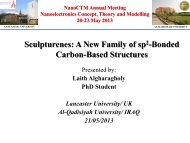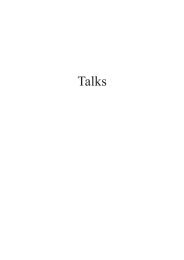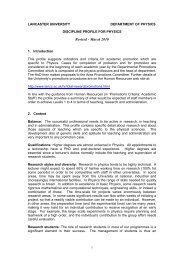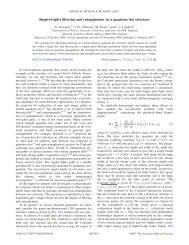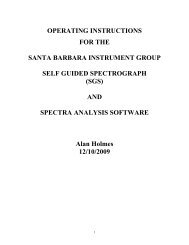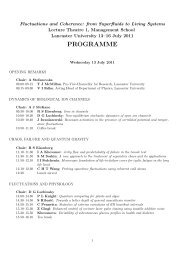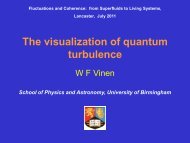Quantum reflection of ultracold atoms from semiconductor surfaces
Quantum reflection of ultracold atoms from semiconductor surfaces
Quantum reflection of ultracold atoms from semiconductor surfaces
Create successful ePaper yourself
Turn your PDF publications into a flip-book with our unique Google optimized e-Paper software.
<strong>Quantum</strong> <strong>reflection</strong> <strong>of</strong><strong>ultracold</strong> <strong>atoms</strong> <strong>from</strong><strong>semiconductor</strong> <strong>surfaces</strong>Mark Fromhold, German Sinuco-León, Tom Judd,Robin Scott, Andrew Martin*, Peter Krüger,Bartek Kaczmareck*School <strong>of</strong> Physics, University <strong>of</strong> Melbourne
Outline• Coherent quantum control <strong>of</strong> atomic Bose-Einsteincondensates (BECs) by solid-state devices• <strong>Quantum</strong> <strong>reflection</strong> <strong>of</strong> a BEC <strong>from</strong> a planar Si surface– Experiments at MIT (Pasquini, Ketterle)– Analysis <strong>of</strong> the experiments– Interactions, vortex rings and cloud shape crucial• Interaction <strong>of</strong> BECs with two-dimensional electron gases– Re-writable alkali-atom lithography <strong>of</strong> quantum devices– Using 2DEGs to overcome present limitations <strong>of</strong> atom chips
Using solid <strong>surfaces</strong>to control BECs• Room-temperature <strong>surfaces</strong>were, traditionally, the enemy<strong>of</strong> cold <strong>atoms</strong>• But, paradoxically, they arenow very useful for trappingand manipulating BECs
Using solid <strong>surfaces</strong>to control BECs• Atom chips (cold chips)– Current-carrying wires micr<strong>of</strong>abricatedon a surface– More later...• Natural <strong>surfaces</strong>– <strong>Quantum</strong> <strong>reflection</strong> can shieldnK BECs <strong>from</strong> disruption by aa room-temperature surfaceonly a few microns awayR. Folman et al.,Phys. Rev. Lett. 84, 4749 (2000)Fortagh & ZimmermannRev. Mod. Phys. 79, 235 (2007)
Motivation for studyingquantum <strong>reflection</strong>• Manipulate BECs using only intrinsic surface potential• Make atom-optical elements, such as mirrors, lensesand cavities, without the need for external fields• Use the <strong>reflection</strong> process to probe both theatom-surface and atom-atom interactions
x<strong>Quantum</strong> <strong>reflection</strong>• Reverses the direction <strong>of</strong> motion where there isno classical turning point• It occurs when the potential varies rapidly with positione.g. a potential stepEnergy
x<strong>Quantum</strong> <strong>reflection</strong>Energy
The potential energy <strong>of</strong> an atom falls rapidly near a surfaceDue to mutual polarization<strong>of</strong> the atom and surface……which creates anintrinsic atom-surfaceattraction:Casimir-Polder potential+-~3 mSolid+ -+ -+ -V CPxCxx
Effect <strong>of</strong> the Casimir-Polder potential on incident <strong>atoms</strong>In a classical picture, no<strong>atoms</strong> would be reflectedSolid~3 mV CPxCx
Effect <strong>of</strong> the Casimir-Polder potential on incident <strong>atoms</strong>In a quantum picture,<strong>reflection</strong> can occurSolid~3 mV CPxCx
Effect <strong>of</strong> the Casimir-Polder potential on incident <strong>atoms</strong>if the deBroglie wavelength spans rapidSolidpotential variation, which requires low v x1~3 mV CPxCxd~ dx
Observing quantum <strong>reflection</strong>Low v x only realized in exceptional systems:1. Helium or hydrogen <strong>atoms</strong> incident on liquid heliumWhere low mass and weak atom-surface attraction allowquantum <strong>reflection</strong> to occur at energies ~ k B x 10 mK[Meyer et al., Cryogenics 3, 150 (1963)]2. Reflection <strong>of</strong> alkali <strong>atoms</strong> <strong>from</strong> a solid surfacerequires incident energy ~ k B x 10 nKFirst achieved for individual cold <strong>atoms</strong> grazingthe surface [F. Shimizu, PRL 86, 987 (2001)]
<strong>Quantum</strong> <strong>reflection</strong> for a BEC T. Pasquini et al.at normal incidence on a Si surface PRL 97, 093201 (2006)rSiliconwaferAtom density pr<strong>of</strong>ile(red high)xBEC prepared in3D magnetic trapEquipotentials <strong>of</strong>3D magnetic trap x = 20 rad s -1
<strong>Quantum</strong> <strong>reflection</strong> for a BEC T. Pasquini et al.at normal incidence on a Si surface PRL 97, 093201 (2006)Equilibrium destroyedSiliconby shifting origin <strong>of</strong>waferthe harmonic trapDxBEC acceleratestowards Si surface & isincident with v x ~ ω x Δx
Experimental image <strong>of</strong> a BECTaken <strong>from</strong> http://cua.mit.edu/ketterle_group/• Containing 300,000 Na <strong>atoms</strong> at 10 nK60 μm
<strong>Quantum</strong> <strong>reflection</strong> <strong>from</strong> a Si surface: experimentPasquini et al. PRL 93, 223201 (2004)
Solved time-dependent Gross-Pitaevskii equation22i2VTRAP ( x,r ) C INTt 2mNonlinear repulsive potential increaseswith increasing atom densityFor a BEC with rotational symmetry about x-axisrxDensity pr<strong>of</strong>ile in x-r plane
Reflection <strong>from</strong> a Si wall (Casimir-Polder potential)Potential pr<strong>of</strong>ileHigh impact velocity: 2.1 mm/sLargedisplacementThe BEC reflects cleanly: no disruption occurs
Reflection <strong>from</strong> a Si wall (Casimir-Polder potential)Potential pr<strong>of</strong>ileLow impact velocity: 1.2 mm/sSmalldisplacementThe BEC becomes disrupted
Frames <strong>from</strong> the movie for low incident speed 1.2 mm/st = 0 mst = 90 msDue to the inter-atomic interactions, the highdensity in the standing wave causes <strong>atoms</strong> to bepushed into “side-lobes”
Frames <strong>from</strong> the movie for low incident speed 1.2 mm/st = 122 mst = 90 mst = 0 msThe “side-lobes” are pushed back towards the axis <strong>of</strong>cylindrical symmetry by the trap, producing a soliton
Frames <strong>from</strong> the movie for low incident speed 1.2 mm/st = 122 mst = 90 mst = 143 mst = 0 msThe soliton decays into two vortex ringsAt the end <strong>of</strong> the oscillation the atomcloud has a fragmented appearance
Frames <strong>from</strong> the movie for low incident speed 1.2 mm/st = 122 mst = 90 mst = 143 mst = 0 msFor lobes to form: lobe formation time < <strong>reflection</strong> timeRadial width Longitudinal width
Expect fragmentation whenImpact speed
Use this shape for studying BEC-surface interactionsThe aspect ratio <strong>of</strong> the atom cloud is crucialA pancake-shaped BEC reflects cleanly even for low v x = 1.2 mm/sbecause <strong>reflection</strong> is over before sidelobes have time to form
Diffraction <strong>of</strong> coherent matter waves by etched surface patterns:Zone-plate focusing <strong>of</strong> a BECMovie by Dominic Walliman
Polarization <strong>of</strong> adsorbed alkali <strong>atoms</strong> locally depletes 2DEGMovie by Dominic Walliman
Scan the zone plate to produce surface patterns that createquantum electronic devices e.g. a quantum dot ?Advantages over existing lithographic techniques:Movie by Dominic Walliman• Non-invasive• Erasable• Scalable
Predict that 2DEG conductors can overcome presentlimits on the functionality & miniaturization <strong>of</strong> atom chips• Can trap <strong>atoms</strong> few 100 nm <strong>from</strong> surface(as opposed to ≥ 5 µm for metal trapping wires)2DEGSinuco-León et al.Phys. Rev. A 83, 021401(R) (2011)BEC
Summary• <strong>Quantum</strong> <strong>reflection</strong> shields nK BECs<strong>from</strong> a room temperature surface• Inter-atomic interactions strongly affectthe <strong>reflection</strong> dynamics• To avoid fragmentation uselow-density pancake-shaped BECs• Interfacing BECs with quantumelectronic devices <strong>of</strong>fer manypossibilities:– Re-writable, low-damage, lithography ?– Smooth, low-noise, near-surface trapsfor miniaturizing atom chipsFor details, see:PRL 100, 100402 (2008);New J. Phys. 12 063033 (2010); Phys. Rev. A 83, 021401(R) (2011); arXiv:1105.2486


